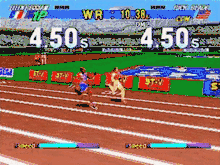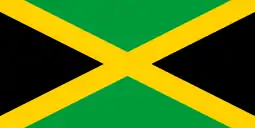DecAthlete
Decathlete,[note 1] released in Europe as Athlete Kings due to a licensing issue,[2] is an track and field themed arcade game. On its unveiling, the gaming media generally described it as a modern clone of Daley Thompson's Decathlon.[1][3][4] Released in 1996, it was developed and produced by Sega. A home port was released on the Sega Saturn in 1996, largely identical to the arcade version, due to the similar hardware of the ST-V hardware and the Saturn. It was released on the PlayStation 2 in Japan only as part of the Sega Ages 2500 series. Compared to other decathlon based games, Decathlete has a more comic and cartoon-like style. A sequel followed in 1997, which was the winter sports-based Winter Heat.
| Decathlete | |
|---|---|
 | |
| Developer(s) | Sega |
| Publisher(s) | Sega |
| Platform(s) | Arcade, Sega Saturn, PlayStation 2 |
| Release | Arcade 1996 Saturn PlayStation 2
|
| Genre(s) | Sport |
| Mode(s) | Up to 2 players simultaneously |
| Arcade system | ST-V[1] |
Gameplay

The overall gameplay is largely based on quick, repeated button pressing for gaining speed, and timed single button presses for jumping and releasing projectiles, in a similar style to the 1983 Konami arcade game, Track & Field. The game differed with a slightly more advanced control system and 3-D graphics.
The player must select one of eight fictional international athletes.[2] In the arcade version, the player competes in ten traditional decathlon events: 100 metres, Long jump, Shot put, High jump, 400 metres, 110 metre hurdles, Discus throw, Pole vault, Javelin throw and 1500 metres. Also in the arcade version, the player is required to meet a minimum set time, height or distance to qualify for the next event. The home console versions allow the player to compete in a full decathlon featuring all ten events without qualifying limit. Despite a potential for multi-player gaming, the game is limited to two players at a time. In a one-player game, the player competes against only one other character from the list of playable characters. The only exception to this is in the 1500 metres, where six other generic athletes join the race as well.
Characters
 Rick Blade: Known as the "Pennsylvanian Power", 25-year-old American athlete Blade is an all-rounder, making him a favourite in many of the events. He is roughly based on legendary athlete Carl Lewis.
Rick Blade: Known as the "Pennsylvanian Power", 25-year-old American athlete Blade is an all-rounder, making him a favourite in many of the events. He is roughly based on legendary athlete Carl Lewis. Karl Vein: A 28-year-old German competitor with long blonde hair who's known for his sheer confidence, to the point of arrogance. Although competitive in all events, he is said to be able to jump over anything.
Karl Vein: A 28-year-old German competitor with long blonde hair who's known for his sheer confidence, to the point of arrogance. Although competitive in all events, he is said to be able to jump over anything. Robin Banks: A veteran at 38 years old, zebra print leotard-clad Banks is the reigning champion from the previous decathlon. The giant Briton is particularly strong in the throwing events. He is roughly similar in appearance to legendary athlete Daley Thompson. For the home releases of the game, his name was changed to Jef Jansens. He was also removed entirely from the US release.
Robin Banks: A veteran at 38 years old, zebra print leotard-clad Banks is the reigning champion from the previous decathlon. The giant Briton is particularly strong in the throwing events. He is roughly similar in appearance to legendary athlete Daley Thompson. For the home releases of the game, his name was changed to Jef Jansens. He was also removed entirely from the US release. Aleksei Rigel: A seasoned decathlon campaigner, Rigel physically the strongest of the eight competitors. This makes the 31-year-old Russian athlete good at throwing events.
Aleksei Rigel: A seasoned decathlon campaigner, Rigel physically the strongest of the eight competitors. This makes the 31-year-old Russian athlete good at throwing events. Joe Kudou: At 19, Japanese athlete Kudou is the youngest of the male competitors and thus lacks experience. He relies on his high skill levels in all event types. He wears a reversed baseball cap.
Joe Kudou: At 19, Japanese athlete Kudou is the youngest of the male competitors and thus lacks experience. He relies on his high skill levels in all event types. He wears a reversed baseball cap. Femi Kadiena: A national record breaker in her home nation, Kadiena has come to break records on the world stage. The 24-year-old Jamaican athlete specialises in jumping events.
Femi Kadiena: A national record breaker in her home nation, Kadiena has come to break records on the world stage. The 24-year-old Jamaican athlete specialises in jumping events. Ellen Reggiani: Due to her speed and stamina, Reggiani is known as the "French Express". The 20-year-old French competitor also works as a model. In others versions, her name was changed to Pilar Jimenez (as was her nationality to Spanish).
Ellen Reggiani: Due to her speed and stamina, Reggiani is known as the "French Express". The 20-year-old French competitor also works as a model. In others versions, her name was changed to Pilar Jimenez (as was her nationality to Spanish). Li Huang: The youngest competitor here at 15, Huang of China has silenced her critics, who object to her age, with her tremendous speed. She received a slight redesign in the US releases to make her appear less childish.
Li Huang: The youngest competitor here at 15, Huang of China has silenced her critics, who object to her age, with her tremendous speed. She received a slight redesign in the US releases to make her appear less childish. Mankichi Kazami: A hidden character available only in the Japanese version of the game on the Sega Saturn. Appears to be based on a character from a Japanese Manga comic, "Decathlon". According to the synopsis of this comic, he is a 20-year-old "yokel" with significant natural athletic ability, but very little knowledge, who simply turns up for trials for the Olympics, having never competed before.
Mankichi Kazami: A hidden character available only in the Japanese version of the game on the Sega Saturn. Appears to be based on a character from a Japanese Manga comic, "Decathlon". According to the synopsis of this comic, he is a 20-year-old "yokel" with significant natural athletic ability, but very little knowledge, who simply turns up for trials for the Olympics, having never competed before.
Reception
| Publication | Score |
|---|---|
| EGM | 8.25/10 (SAT)[5] |
| Next Generation | |
| Sega Saturn Magazine | 91% (SAT)[7] |
In Japan, Game Machine listed Decathlete on their July 1, 1996 issue as being the most-successful arcade game of the year.[8]
A reviewer for Next Generation said that compared to its rival, Konami's International Track & Field, DecAthlete has far more polygons, producing characters which are "completely smooth, crisp, and full of life." He also praised the variety of events, strong selection of modes and features, heavy distinction between the playable characters, and emphasis on timing and skill over button-mashing, which he felt set it apart from previous track-and-field games. His one criticism is that it supports up to two players, compared to International Track and Field's four players.[6] The two sports reviewers of Electronic Gaming Monthly both commented that the game rose above simple button-mashing and had a strong sense of realism.[5] Rob Allsetter of Sega Saturn Magazine highlighted the 60 frames per second animation, and agreed with Next Generation and EGM that, while DecAthlete does involve some button-mashing, it emphasizes skill conspicuously more than other games in the genre. He also agreed that the game's one shortcoming is that it does not support more than two players.[7]
In 1997 Electronic Gaming Monthly listed the Saturn version as number 95 on their "100 Best Games of All Time", calling it "the ultimate sports game for people who aren't into sports games." They cited its excellent graphics, control, and camera angles, and the humorous characters.[9]
Notes
- デカスリート Dekasurīto
References
- "The ST-V Board in Surprise Resurgence Shocker!". Maximum: The Video Game Magazine. Emap International Limited (5): 119. April 1996.
- Bright, Rob (August 1996). "Get on the Good Foot". Sega Saturn Magazine. No. 10. Emap International Limited. pp. 42–47.
- "Model 3: Sega Affirms Arcade Supremacy". Next Generation. No. 17. Imagine Media. May 1996. pp. 12–18.
- "And There's More...". Sega Saturn Magazine. No. 6. Emap International Limited. April 1996. p. 17.
- "Box Score: Decathlete". Electronic Gaming Monthly. No. 86. Ziff Davis. September 1996. p. 142.
- "Decadent". Next Generation. No. 22. Imagine Media. October 1996. p. 175.
- Allsetter, Rob (September 1996). "Review: Athlete Kings". Sega Saturn Magazine. No. 11. Emap International Limited. pp. 66–67.
- "Game Machine's Best Hit Games 25 - TVゲーム機ーソフトウェア (Video Game Software)". Game Machine (in Japanese). No. 521. Amusement Press, Inc. 1 July 1996. p. 21.
- "100 Best Games of All Time". Electronic Gaming Monthly. No. 100. Ziff Davis. November 1997. p. 104. Note: Contrary to the title, the intro to the article explicitly states that the list covers console video games only, meaning PC games and arcade games were not eligible.
